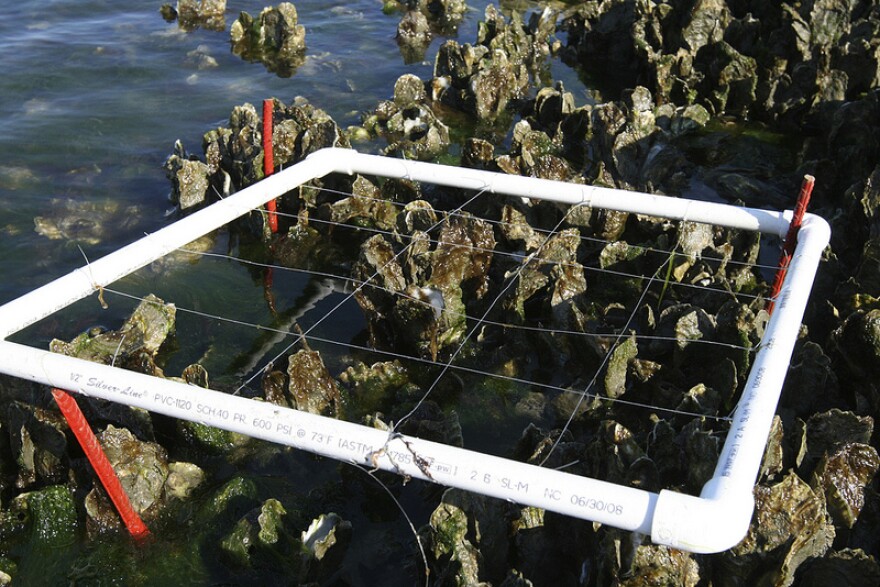We speak to an eastern North Carolina based scientist who is part of a research project aimed at changing federal regulations surrounding the harvest of oysters in our state.
Cooler temperatures and changing foliage are signs of Fall. Another indicator is start of oyster season… But before those fresh oysters make it to your dinner table, they are harvested adhering to strict guidelines enforced by the FDA. These polices were developed using data on temperature and bacterial levels collected from the Gulf Coast. Now, a team of researchers and scientists across the state are involved in a study to determine if the bacteria levels in North Carolina waters differ from the Gulf. Post-doctorate researcher at the University of North Carolina’s Institute of Marine Science Dr. Brett Froelich says the bacteria Vibrio vulnificus is commonly found in waters where oysters are harvested, and eating them raw increases the likelihood of being infected.
“People who typically come down with disease which can be quite deadly are men who are over 40 who drink.”
People with a liver impalement, diabetes or any other disease that affects the immune system are also at risk.
“These bacteria can cause illnesses ranging from just upset stomach or diarrhea, or even death in extreme cases from the bacteria spreading throughout your body and attacking your organs and your system just shuts down.”
The simplest way to prevent being infected by the disease is to steam the oysters 3 to 5 minutes which kills the harmful bacteria. The Food and Drug Administration aims to keep those who insist on eating raw oysters safe by imposing restrictions on how oysters are harvested, minimizing the chance for bacteria to grow. Dr. Froelich restrictions limit the amount of time it takes from the harvest of an oyster to when it’s put on ice.
“As soon as they pull them out of the water, the clock starts ticking to when they have to bring them to a certain temperature. When those restrictions are at their greatest, that of course limits the amount of time they can harvest, and it limits the distance at which they can harvest the oysters before they can start bringing them back. Add those restrictions in and it lowers the amount of landings, of oyster landings that you’re going to get from those endeavors.”
These restrictions are normally in place during the warm weather harvesting months. When oysterman aren’t able to meet those requirements, they have to sell the product at a lower quality, which means less profit. Some, including Dr. Froelich feel the FDA’s regulations are too burdensome and don’t accurately reflect the unique conditions of our coastal areas.
“Those restrictions are put into place based on data from the Gulf Coast and their oysters and their particular set of bacteria. We get lumped into those restrictions here in the state of North Carolina based solely on our average water temperature and not on any data based on the bacteria that are currently in our waters.”

Dr. Froelich and a team of scientists are involved in a research project that started in January that involves gathering information about the different types of bacteria specific to our coastal waters. The study is funded by a donation from Dr. Barbara Entwisle, Vice Chancellor for Research, University of North Carolina. The goal is to develop a salinity and temperature profile that can serve as an indicator of risk of infection when consuming raw oysters.
“I’m the one who shucks the oysters, pulls out the meat, and actually does a lot of the bacterial analysis or at least a good portion of it.”
The North Carolina Division of Marine Fisheries collects oyster samples twice a week from four to six different locations along the coast. Then they’re taken to the Institute of Marine Science where Dr. Froelich shucks the oysters, dilutes them in a saline solution and makes an oyster smoothie, of sorts. Blending the oyster meat allows him access the bacteria contained inside the inner tissues.

“Once the oysters are liquefied, I pull them out and I put them on different petri plates that have various antibiotics or various nutrients so we can tell the different bacteria apart. I give those a day or so to grow and I count and identify specific ones.”
Samples that require further examination are frozen and sent to the University of North Carolina at Charlotte for further study. Their research has been going on for nine months, and Dr. Froelich says they’re seeing results.
“Our salinities are actually much higher and for some types of these bacteria that higher salinity has a negative effect on that bacteria and so the increased salinity actually keeps those numbers lower and so therefore our oysters tend to have less of those bacteria.”
Currently, the FDA only considers salinity and temperature as factors that cause bacteria growth. But as part of this study, Dr. Froelich is also trying to determine if pH or the amount of dissolved material in the water has any effect on the amount of bacteria present in North Carolina oysters versus Gulf oysters.

The study is expected to conclude in early 2014 and a presentation of the findings will be made to the FDA. Dr. Froelich hopes to prove that a one size fits all method of regulating oyster harvesting is not the answer.
“Rather than say North Carolina specifically, it would be nice to see if this became like an East Coast, mid-Atlantic region. Rather, Like if there were a Gulf Coast region then there was a Mid-Atlantic region rather than everyone in the nation just fall into the same guidelines.”
Dr. Froelich hopes they can secure funding to extend the study for another year. I’m Jared Brumbaugh.



